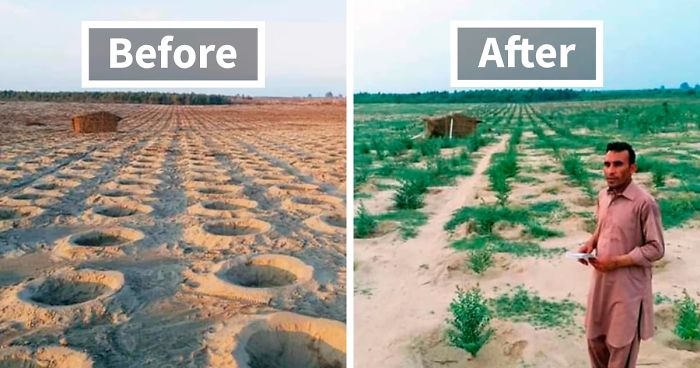
See How The “10 Billion Tree Tsunami” Tree Planting Campaign Transformed This Area Between 2019 And 2020
Within the last year, planting trees was the thing to do in easing the negative effects of climate change. This is evident by the slew of various tree-planting initiatives that were organized, including Team Trees where 600 YouTubers pledged to plant 20 million trees, Ethiopia breaking the world record by planting over 350 million trees in half a day, and these 13 feel-good stories about saving our planet.
While the coronavirus has taken over airtime in recent months, the need for tree-planting never went away with many of these initiatives continuing to plant trees. And many are making good progress on their goals.
One such initiative is the 10 Billion Tree Tsunami, Pakistan’s largest ever tree plantation project, which recently had an update on its progress in the form of a before and after video that has been making people gasp in wonder.
It takes years for some of us to get simple things done, but nature is better at reaching its goals
Pakistan’s Advisor to the Minister of Climate Change shared an inspiring before-and-after video of how much the natural landscape in Balloki changed in a year
Image credits: Malik Amin Aslam
Malik Amin Aslam, Pakistan’s Advisor to the Prime Minister and Federal Minister of Climate Change, shared a video on his Twitter of what the Balloki Nature Reserve near Lahore in the Punjab district looked like a year ago, and what it looks like now.
The video shows barren land with virtually no greenery for miles, a sight that was seen during Aslam’s visit to the area a year ago. Today, it is a luscious and prosperous area fully paved with grass and trees.
The caption read: “Was a treat to visit #BallokiNatureReserve #Lahore after a year – #PMIK @ImranKhanPTI inaugurated this in 2019 as part of #10BillionTreeTsunami and the plantation results in a year are phenomenal – #Change and #NayaPakistan IA”.
This change is a part of the 10 Billion Tree Tsunami project which aims to reforest Pakistan
Image credits: Malik Amin Aslam
10 Billion Tree Tsunami is a government launched and funded project to promote reforestation in Pakistan. The project hopes to plant 10 billion trees within the span of five years, and to achieve a number of other objectives, including to increase forest area, rehabilitate degraded forests, to protect green areas and its wildlife, to provide jobs, among many others.
You see, trees help to protect the soil from degradation and to regulate water on farms, mitigate floods, and enrich the soil and surrounding areas with biodiversity. Also, crops grown in forested areas are often more resilient to the impact of droughts, excessive rains, and extreme weather.
The project aims to increase forest area, rehabilitate degraded forests, and protect green areas and the wildlife living in it, among other objectives
Image credits: Malik Amin Aslam
So far in 2020, 20,798 hectares of plantations were planted to achieve these aims. The Redd Monitor reports that a total of 350,000 hectares of trees were already planted in both planting and natural regeneration form and that the project has also created around 3,500 green enclosures in state-owned forests.
Back in February, the ministry announced their plan to plant 250 million saplings this spring in hopes of populating the bare bits of land around cities. However, it is not clear whether this has been achieved because of the coronavirus and the subsequent lockdown.
The project includes 3 regions with 27 divisions and progress is seen in many locations across the country
Image credits: Malik Amin Aslam
So far, a total of 350,000 hectares were planted with trees, creating 3,500 green enclosures nation-wide
Image credits: Ten Billion Tree Tsunami
The project earned great recognition, including that from the World Economic Forum, WWF, and IUCN
The project has come under fire for a number of reasons. There have been alleged reports of bogus billing, fake plantation, poor quality earthwork, unauthorised payments, and other activities that hint at corruption.
Besides that, it was also reported by the Redd Monitor that the coronavirus lockdown has also led to planters earning around 500 rupees a day—half of what they could on a good day before the pandemic, meaning that they now earn less than minimum wage (which is approx. 800 per day).
Despite this, the project has managed to earn a number of awards and wider recognition over the years, including that from the World Economic Forum, WWF, IUCN, and was ranked 4th biggest initiative by the Plant for Planet Foundation (UNFCCC). And now that people can see more results of the initiative in Aslam’s video, it’s safe to say that the project is going somewhere and both the planet and, subsequently, humanity will benefit from it in the long run.
Besides restoring natural landscapes, the project also plans to create jobs and ensure greater wildlife security
With its 10 billion tree “tsunami”, Pakistan joins a number of other massive tree-planting projects, including the aforementioned Ethiopia’s record-breaking campaign that managed to plant 350 million saplings in 12 hours. Another attempt at breaking the record happened in India, where 1.5 million volunteers planted 66 million trees in the same timespan, showing just how much more natural the world has become over the recent years.
What did you think about this? Have you had a chance to plant a tree, and if so, which one? Let us know in the comment section below!
That's why I donate to onetreeplanted.org. Literally a dollar for a tree. Wanted to help Australia but you can choose any region.
Load More Replies...It's like one of those, "why on Earth isn't everyone doing that?" moments. What's not to love about it?? Green, healthy, beautiful, helping the environment whilst supporting the economy. Everywhere should be green!!
And then when you decide you want to make a huge goal to plant a million trees you decide, “It can wait for a few more months.”
Load More Replies...Being a Pakistani, I know, environmental issues or plantation are never on any government's action plans. This was indeed a feat achieved by current government and hope this keeps thriving and open our closed selfish minds.
Sadly, the governments everywhere in the world do not care about the environment, animals, and people. The corruption and greed runs wild. We can't let them get away with it.
Load More Replies...Enviromental protection is one thing all Pakistanis agree on. I'm so proud to see some progress!
Now we clean up the river I can't spell, and we're on the right track!
Load More Replies...Its amazing how they were able to do that. It would be a cool timelapse
I'm waiting for this project to complete just so i could see that time-lapse even if the project achieved nothing else bet the time lapse would make it worth it
Load More Replies...Beautiful.I grew up in former Yugoslavia.As a part of our school curriculum we had to attend a tree planting day once a year.All students had to go and plant seedlings all day.It was always a fun day.This was many years ago and these areas are beautiful pine forests now !
Awesome. We got plants donated to us during arbor day here in the states in maine. We'd bring them home, find a cool place and plant them..my mom's yard is the most lush green place..trees create a natural shade..and all the trees we planted over the years...so tall. Its a great feeling.
Load More Replies...Wonderful. And in the US and a lot of countries we just keep destroying.
...... recently, overturning the environmental protection laws and selling off the public lands to polluters.
Load More Replies...It's wonderful. However, in the North West of the country, they are decimating entire forests and bringing that timber down to lahore, karachi, and the like.
Yes. It seems as if the North West is causing serious pollution problems to the river and land alike.
Load More Replies...They will be grown in a nursery. The seeds are planted in small containers with good soil and take care of until they are mature enough to be planted in the ground.
Load More Replies...Amazing work all these folks have done with amazingly quick results! Now I feel inadequate for only planting 4 trees this winter.
Love this !!! I suport TREENATION with base in Barcelona. There you can buy a tree up from 3 Euro all over the world. I have already 5 and i´m addicted. there are many more, but I can only send you this report in german, and at the end, there are more adresses ... Thanx for your support for a better world! Love from Germany!
https://utopia.de/ratgeber/baeume-pflanzen-fuers-klima-empfehlenswerte-organisationen/
Load More Replies...Malik amin Aslam is from my hometown and I know very well about the progress, his work is beyond one's imaginations, I endorse his efforts to fight climate change. 🇵🇰 we Pakistanis are very happy to be a part in global fight of climate change, I hope we will achieve the target on time,
So there's a riot on this project, I've seen video my pakistani friend posted online showed the people storming the area and destroys the plants. This was due to the project took over some private properties without consent.
You really need to make sure that the weather isn't going to kill your beautiful transformations. The toxins used to control weather, nearly every day, poisons your water, your soil, your pets, you, etc.
This is awesome! I am going to do research on this and see what I can do in regards of becoming a part of this project! Movement! Good cause!
In the most parts of pakistan the soil is moist, the underground water reservoirs are just 10 metres deep the ground level which keeps the soil moist and also the rains are frequent, they do watering the baby plants for few weeks and it start growing on its own.
Load More Replies...Mmm I have my doubts, in one picture of before and after the before has a metal structure and the after does not, just saying
That's why I donate to onetreeplanted.org. Literally a dollar for a tree. Wanted to help Australia but you can choose any region.
Load More Replies...It's like one of those, "why on Earth isn't everyone doing that?" moments. What's not to love about it?? Green, healthy, beautiful, helping the environment whilst supporting the economy. Everywhere should be green!!
And then when you decide you want to make a huge goal to plant a million trees you decide, “It can wait for a few more months.”
Load More Replies...Being a Pakistani, I know, environmental issues or plantation are never on any government's action plans. This was indeed a feat achieved by current government and hope this keeps thriving and open our closed selfish minds.
Sadly, the governments everywhere in the world do not care about the environment, animals, and people. The corruption and greed runs wild. We can't let them get away with it.
Load More Replies...Enviromental protection is one thing all Pakistanis agree on. I'm so proud to see some progress!
Now we clean up the river I can't spell, and we're on the right track!
Load More Replies...Its amazing how they were able to do that. It would be a cool timelapse
I'm waiting for this project to complete just so i could see that time-lapse even if the project achieved nothing else bet the time lapse would make it worth it
Load More Replies...Beautiful.I grew up in former Yugoslavia.As a part of our school curriculum we had to attend a tree planting day once a year.All students had to go and plant seedlings all day.It was always a fun day.This was many years ago and these areas are beautiful pine forests now !
Awesome. We got plants donated to us during arbor day here in the states in maine. We'd bring them home, find a cool place and plant them..my mom's yard is the most lush green place..trees create a natural shade..and all the trees we planted over the years...so tall. Its a great feeling.
Load More Replies...Wonderful. And in the US and a lot of countries we just keep destroying.
...... recently, overturning the environmental protection laws and selling off the public lands to polluters.
Load More Replies...It's wonderful. However, in the North West of the country, they are decimating entire forests and bringing that timber down to lahore, karachi, and the like.
Yes. It seems as if the North West is causing serious pollution problems to the river and land alike.
Load More Replies...They will be grown in a nursery. The seeds are planted in small containers with good soil and take care of until they are mature enough to be planted in the ground.
Load More Replies...Amazing work all these folks have done with amazingly quick results! Now I feel inadequate for only planting 4 trees this winter.
Love this !!! I suport TREENATION with base in Barcelona. There you can buy a tree up from 3 Euro all over the world. I have already 5 and i´m addicted. there are many more, but I can only send you this report in german, and at the end, there are more adresses ... Thanx for your support for a better world! Love from Germany!
https://utopia.de/ratgeber/baeume-pflanzen-fuers-klima-empfehlenswerte-organisationen/
Load More Replies...Malik amin Aslam is from my hometown and I know very well about the progress, his work is beyond one's imaginations, I endorse his efforts to fight climate change. 🇵🇰 we Pakistanis are very happy to be a part in global fight of climate change, I hope we will achieve the target on time,
So there's a riot on this project, I've seen video my pakistani friend posted online showed the people storming the area and destroys the plants. This was due to the project took over some private properties without consent.
You really need to make sure that the weather isn't going to kill your beautiful transformations. The toxins used to control weather, nearly every day, poisons your water, your soil, your pets, you, etc.
This is awesome! I am going to do research on this and see what I can do in regards of becoming a part of this project! Movement! Good cause!
In the most parts of pakistan the soil is moist, the underground water reservoirs are just 10 metres deep the ground level which keeps the soil moist and also the rains are frequent, they do watering the baby plants for few weeks and it start growing on its own.
Load More Replies...Mmm I have my doubts, in one picture of before and after the before has a metal structure and the after does not, just saying
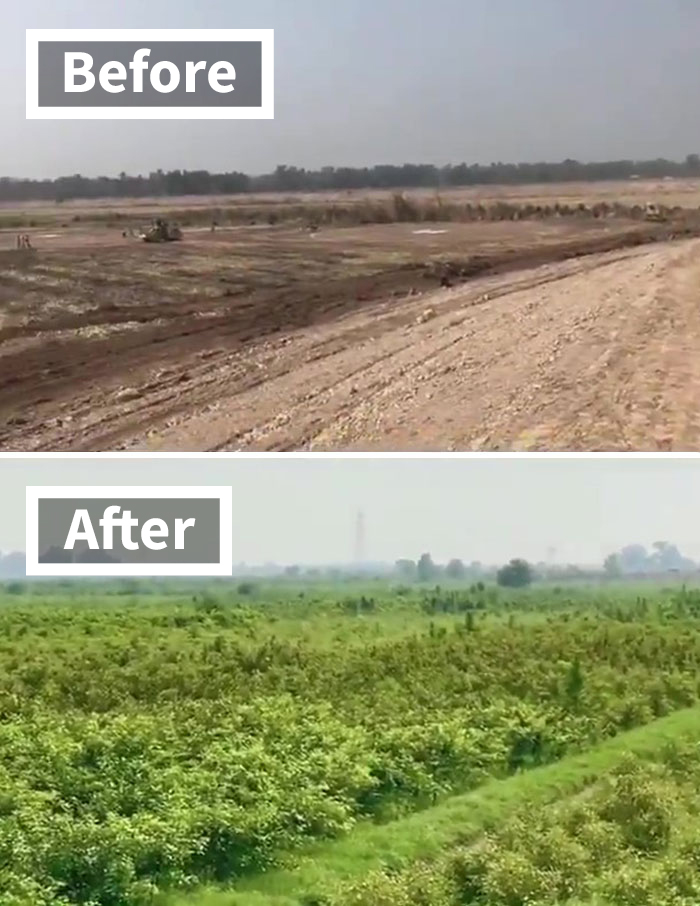
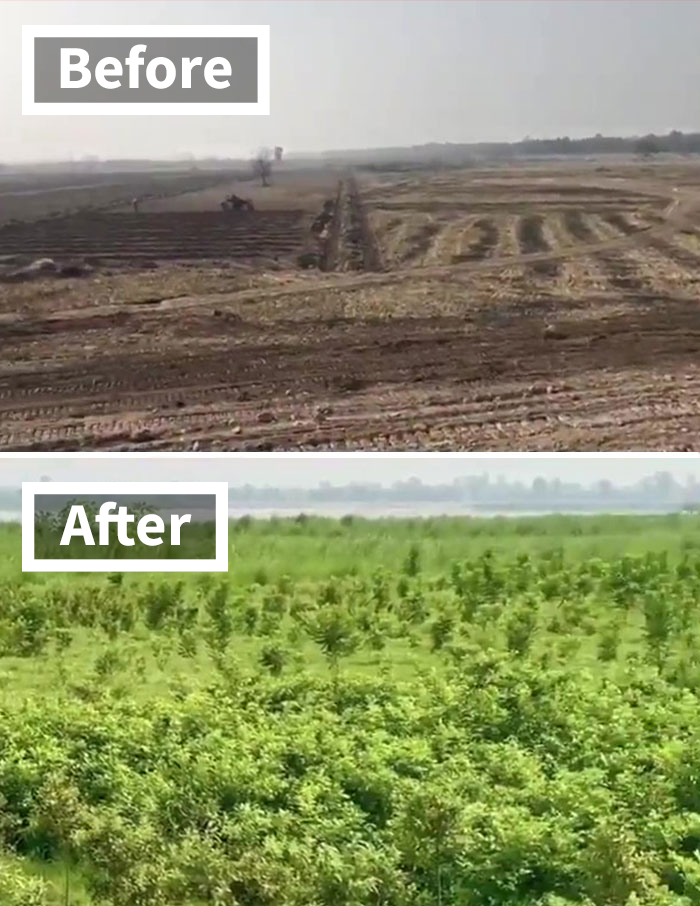
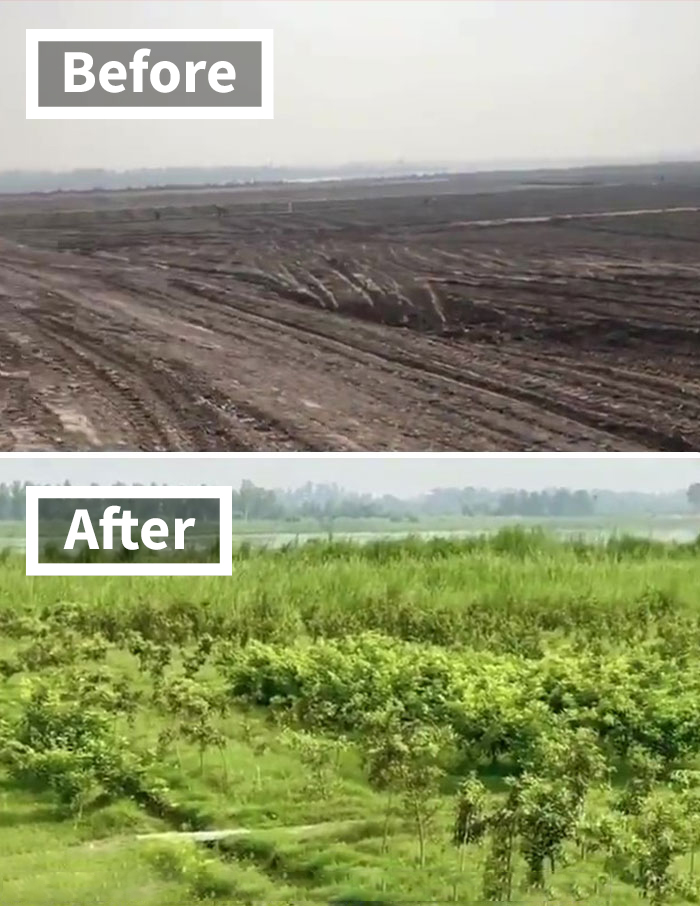
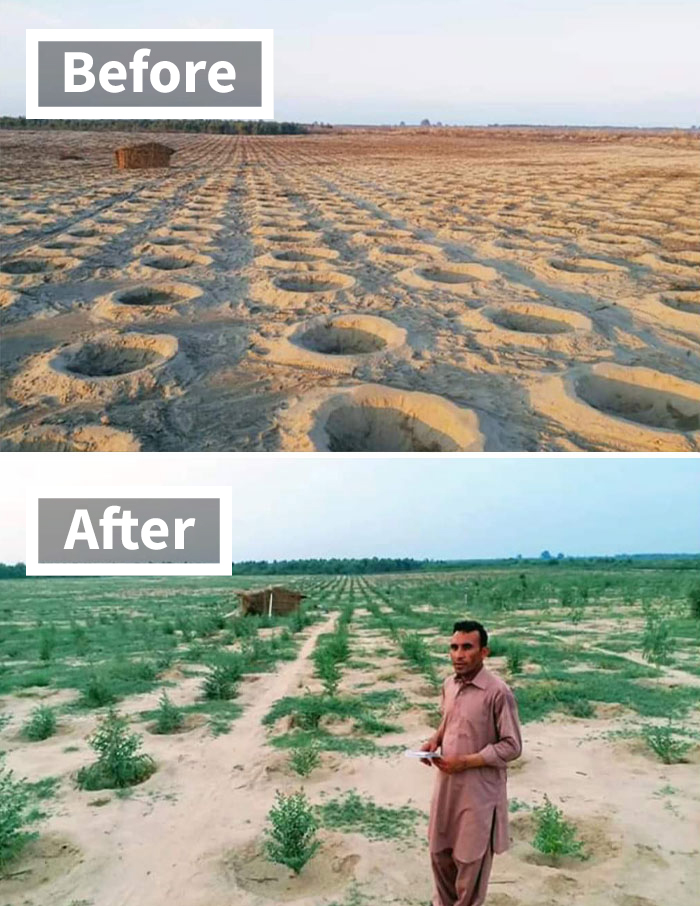
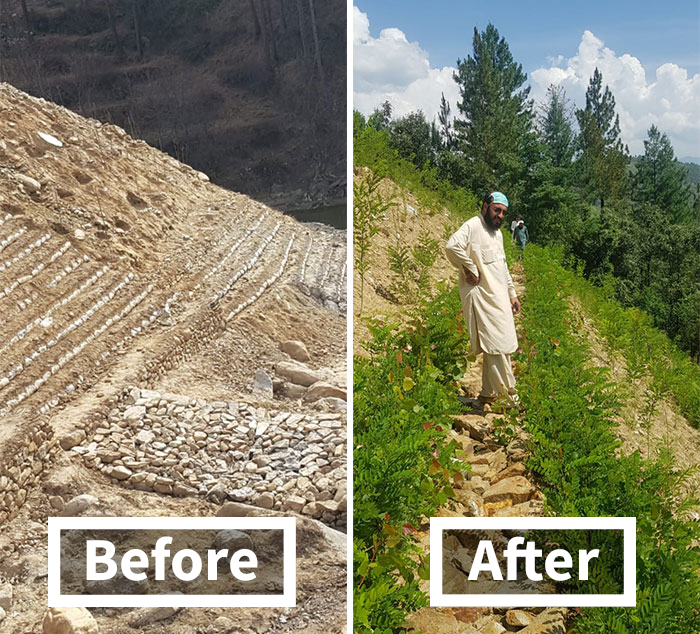



392
60